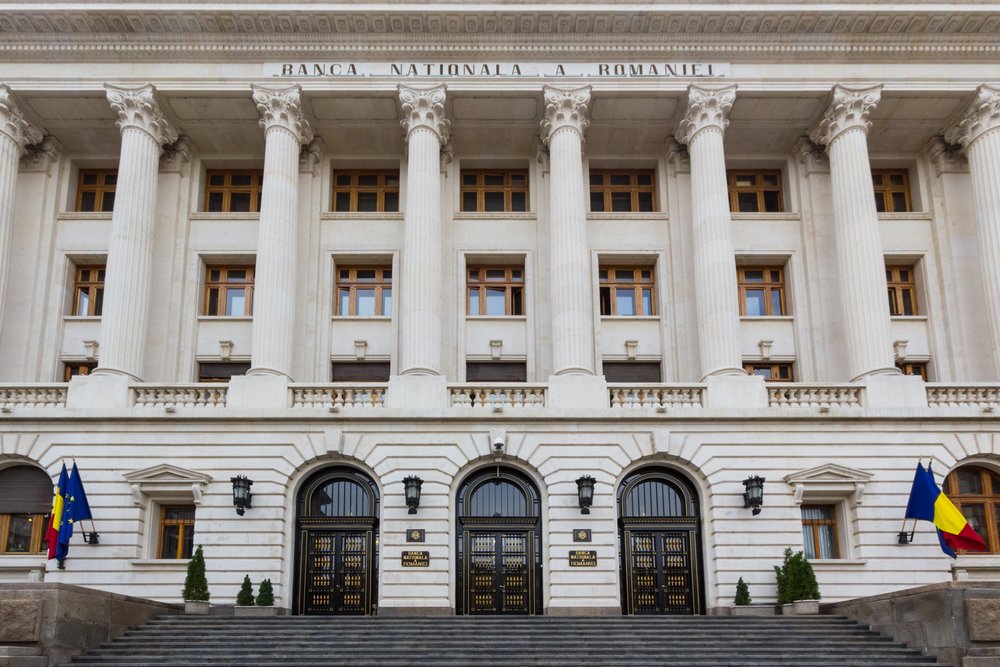In its meeting of 4 April 2024, the Board of the National Bank of Romania (NBR) decided to keep the monetary policy rate at 7.00 percent per annum and to leave unchanged the lending (Lombard) facility rate at 8.00 percent per annum and the deposit facility rate at 6.00 percent per annum. The Romanian central bank also decided to keep the existing levels of minimum reserve requirement ratios on both leu- and foreign currency-denominated liabilities of credit institutions.
The annual inflation rate went up in January 2024 in line with forecasts to reach 7.41 percent, from 6.61 percent in December 2023, whereas in February it declined to 7.23 percent. The advance against the end of 2023 is mainly attributable to the sharp increase in the annual dynamics of electricity prices under the impact of a base effect, as well as to the pick-up in the prices of fuels and tobacco products amid the hike in excise duties and higher crude oil prices.
The annual adjusted CORE2 inflation rate continued to decrease in the first two months of 2024, albeit at a relatively slower pace, falling to 7.6 percent in February 2024, from 8.4 percent in December 2023. Behind the deceleration during this period further stood disinflationary base effects, corrections of agri-food commodity prices and the measure to cap the mark-ups on basic food products, alongside the decreasing dynamics of import prices. The impact of these factors was mitigated by the effects of the fiscal measures implemented at the beginning of 2024 and by higher short-term inflation expectations, as well as by the pass-through, at least in part, of the new increases in wage costs into the prices of some services and goods, inter alia amid the rebound in consumer demand.
The annual inflation rate calculated based on the Harmonised Index of Consumer Prices (HICP – inflation indicator for EU Member States) amounted to 7.1 percent in February 2024 compared to 7.0 percent in December 2023. Nevertheless, the average annual CPI inflation rate went down to 9.1 percent in February 2024, from 10.4 percent in December 2023. In turn, the average annual HICP inflation rate decreased to 8.7 percent in February 2024 from 9.7 percent in December 2023.
In 2023 Q4, economic activity weakened more than anticipated, contracting by 0.5 percent versus the previous three months, after a 1.0 percent increase in Q3, which makes it likely for excess aggregate demand to narrow more visibly over this period compared to expectations.
Conversely, annual GDP growth rose to 3.0 percent in 2023 Q4 from 1.9 percent in Q3. This was further bolstered in 2023 Q4 primarily by gross fixed capital formation, but household consumption also made a significantly larger contribution than in the previous quarter, following the re-acceleration of purchases of goods and services.
However, the contribution of net exports saw a renewed strong contraction in 2023 Q4, given that the annual change in the imports of goods and services rebounded, re-entering positive territory and thus outpacing that of exports. Consequently, the trade deficit and the current account deficit posted an annual increase during this period – after three quarters of decline –which, in the latter’s case, was amplified by the marked worsening of the primary income balance. However, in 2023 overall, both deficits narrowed visibly versus 2022.
The latest data and analyses point to a more robust quarter-on-quarter economic growth in 2024 Q1 than previously forecasted, implying however a drop in the annual growth rate of GDP during this period, amid divergent developments in aggregate demand components and major sectors.
Thus, compared to the average dynamics in 2023 Q4, in January 2024 retail sales posted a significantly faster annual rise, while industrial output reported a notable re-widening in its contraction and the volume of construction works saw a sharp annual decline after six consecutive quarters of double-digit growth. Moreover, the annual dynamics of imports of goods and services exceeded further those of exports, although to a lower extent than in 2023 Q4, marginally re-entering negative territory in January 2024. Against this background, the trade deficit witnessed a slower annual increase, whereas the current account deficit posted a considerably faster expansion, as a result of the deterioration of income balances.
Looking at the labour market, the number of employees economy-wide resumed its monthly increase in December 2023 and the two-digit annual dynamics of unit labour costs in industry re-accelerated in 2023 Q4, while the ILO unemployment rate advanced slightly in early 2024, after three quarters of relative stagnation, at an average 5.6 percent level. At the same time, employment intentions over the very short horizon saw an upturn in February-March 2024, while the labour shortage widened in 2024 Q1 overall, on account of developments in services and construction, according to the latest surveys.
The main interbank money market rates remained relatively stable in February and in the first part of March, but then recorded new mild declines, while long-term yields on government securities stayed on a markedly upward, yet strongly fluctuating path, similarly to developments in advanced economies and in the region. This occurred amid the revision and subsequent consolidation of investor expectations for the timing and magnitude of interest rate cuts by the Fed, with an impact on global risk appetite as well. Against this background, the EUR/RON exchange rate stuck in February to the higher readings reached in mid-January, but then witnessed a slight downward correction, returning and stabilising in March close to the values prevailing in 2023 Q4.
The annual growth rate of credit to the private sector re-embarked on a downward course in January 2024, falling to 4.9 percent in February from 6.4 percent in December 2023. This was mainly due to a renewed sharp slowdown in the dynamics of the foreign currency component, but also to the mild deceleration in the pace of increase of domestic currency credit. Against this background, the share of leu-denominated loans in credit to the private sector widened to 68.7 percent in February 2024 from 68.4 percent in December 2023.
According to current assessments, the annual inflation rate will decline further over the following months, on a slightly higher path than that shown in the February 2024 medium-term forecast, primarily due to base effects and downward corrections of agri-food commodity prices, as well as amid the deceleration in import price growth and the gradual downward adjustment of short-term inflation expectations.
Uncertainties and risks to the inflation outlook further stem, however, from the fiscal measures implemented recently for underpinning the budget consolidation process, as well as from the measure to cap the mark-ups on basic food products, extended until end-2024, but also from the evolution of crude oil prices.
Moreover, heightened uncertainties and risks are associated with the future fiscal and income policy stance, coming on one hand from the budget execution in the first two months of the year, the public sector wage dynamics and the full impact of the new law on pensions, and on the other hand from the additional fiscal and budgetary measures that might be implemented in the future to carry on budget consolidation, inter alia amid the excessive deficit procedure and the conditionalities attached to other agreements signed with the EC. Wage dynamics in the economy are a source of concern.
Uncertainties and risks to the outlook for economic activity, implicitly the medium-term inflation developments, also continue to arise, nevertheless, from the war in Ukraine and the Middle East conflict, as well as from the economic performance in Europe, particularly in Germany. Furthermore, the absorption of EU funds, especially those under the Next Generation EU programme, is conditional on fulfilling strict milestones and targets. However, this is essential for carrying out the necessary structural reforms, energy transition included, as well as for counterbalancing, at least in part, the contractionary impact exerted by geopolitical conflicts and by the tighter economic and financial conditions worldwide.
The ECB’s and the Fed’s prospective monetary policy stances are also relevant, as well as the conduct of central banks in the region.
In the meeting held today, 4 April 2024, based on the currently available data and assessments, as well as in light of the elevated uncertainty, the NBR Board decided to keep the monetary policy rate at 7.00 percent per annum. Moreover, it decided to leave unchanged the lending (Lombard) facility rate at 8.00 percent per annum and the deposit facility rate at 6.00 percent per annum. Furthermore, the NBR Board decided to keep the existing levels of minimum reserve requirement ratios on both leu- and foreign currency-denominated liabilities of credit institutions.
The NBR Board decisions aim to bring the annual inflation rate back in line with the 2.5 percent ±1 percentage point flat target on a lasting basis, inter alia by anchoring inflation expectations over the medium term, in a manner conducive to achieving sustainable economic growth. At the current juncture, the balanced macroeconomic policy mix and the implementation of structural reforms, also by using EU funds to foster the growth potential over the long term, are of the essence in preserving a stable macroeconomic framework and strengthening the capacity of the Romanian economy to withstand adverse developments.
The NBR closely monitors developments in the domestic and international environment and will continue to use the tools at its disposal to achieve the fundamental objective of price stability in the medium term.
The account (minutes) of discussions underlying the adoption of the monetary policy decision during today’s meeting will be posted on the NBR’s website on 16 April 2024 at 3:00 p.m.
In line with the announced calendar, the next monetary policy meeting of the NBR Board will be held on 13 May 2024.
The post NBR maintained the key interest rate at 7% annually appeared first on The Romania Journal.




